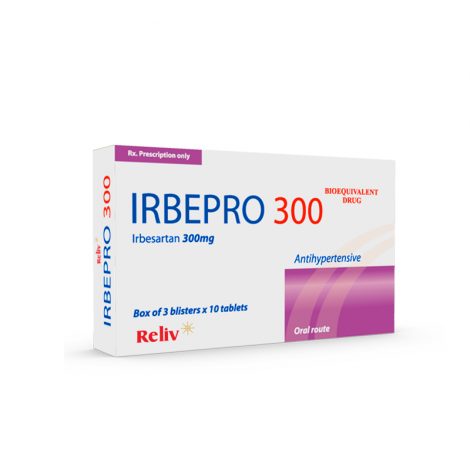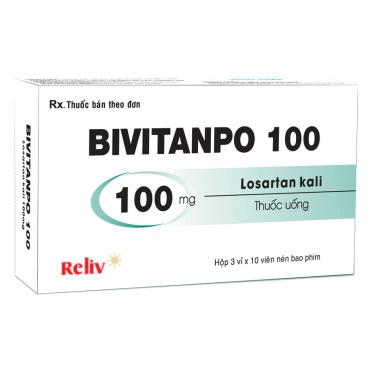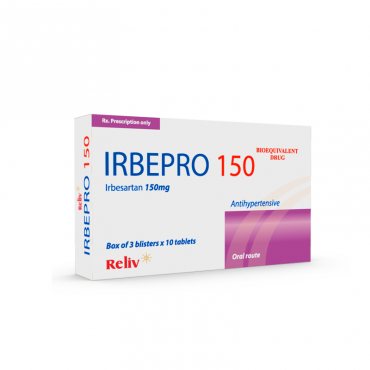The usual recommended initial and maintenance dose is 150 mg once daily, with or without food. Irbesartan Tablet at a dose of 150 mg once daily generally provides a better 24 hours blood pressure control than 75 mg. However, initiation of therapy with 75 mg could be considered, particularly in haemodialysed patients and in the elderly over 75 years.
In patients insufficiently controlled with 150 mg once daily, the dose of Irbesartan can be increased to 300 mg, or other antihypertensive agents can be added. In particular, the addition of a diuretic such as hydrochlorothiazide has been shown to have an additive effect with Irbesartan.
In hypertensive type 2 diabetic patients, therapy should be initiated at 150 mg irbesartan once daily and titrated up to 300 mg once daily as the preferred maintenance dose for treatment of renal disease.
The demonstration of renal benefit of Irbesartan in hypertensive type 2 diabetic patients is based on studies where irbesartan was used in addition to other antihypertensive agents, as needed, to reach target blood pressure.
Special Populations
Renal impairment: No dosage adjustment is necessary in patients with impaired renal function. A lower starting dose (75 mg) should be considered for patients undergoing haemodialysis.
Hepatic impairment: No dosage adjustment is necessary in patients with mild to moderate hepatic impairment. There is no clinical experience in patients with severe hepatic impairment.
Elderly: Although consideration should be given to initiating therapy with 75 mg in patients over 75 years of age, dosage adjustment is not usually necessary for the older people.
Paediatric population: The safety and efficacy of Irbesartan in children aged 0 to 18 has not been established.
METHOD OF ADMINISTRATION
For oral use.
• Hypersensitivity to the active substance(s) or to any of the excipients of this drug
• Second and third trimester of pregnancy.
• The concomitant use of Irbesartan with aliskiren-containing products is contraindicated in patients with diabetes mellitus or renal impairment (glomerular filtration rate (GFR) < 60 ml/min/1.73 m2).
Intravascular volume depletion: symptomatic hypotension, especially after the first dose, may occur in patients who are volume and/or sodium depleted by vigorous diuretic therapy, dietary salt restriction, diarrhoea or vomiting. Such conditions should be corrected before the administration of Irbesartan.
Renovascular hypertension: there is an increased risk of severe hypotension and renal insufficiency when patients with bilateral renal artery stenosis or stenosis of the artery to a single functioning kidney are treated with medicinal products that affect the renin-angiotensin-aldosterone system. While this is not documented with Irbesartan, a similar effect should be anticipated with angiotensin-II receptor antagonists.
Renal impairment and kidney transplantation: when Irbesartan is used in patients with impaired renal function, a periodic monitoring of potassium and creatinine serum levels is recommended. There is no experience regarding the administration of Irbesartan in patients with a recent kidney transplantation.
Hypertensive patients with type 2 diabetes and renal disease: the effects of Irbesartan both on renal and cardiovascular events were not uniform across all subgroups, in an analysis carried out in the study with patients with advanced renal disease. In particular, they appeared less favourable in women and non-white subjects.
Dual blockade of the renin-angiotensin-aldosterone system (RAAS):
There is evidence that the concomitant use of ACE-inhibitors, angiotensin II receptor blockers or aliskiren increases the risk of hypotension, hyperkalaemia and decreased renal function (including acute renal failure). Dual blockade of RAAS through the combined use of ACE-inhibitors, angiotensin II receptor blockers or aliskiren is therefore not recommended. If dual blockade therapy is considered absolutely necessary, this should only occur under specialist supervision and subject to frequent close monitoring of renal function, electrolytes and blood pressure.
ACE-inhibitors and angiotensin II receptor blockers should not be used concomitantly in patients with diabetic nephropathy.
Hyperkalaemia: as with other medicinal products that affect the renin-angiotensin-aldosterone system, hyperkalaemia may occur during the treatment with Irbesartan, especially in the presence of renal impairment, overt proteinuria due to diabetic renal disease, and/or heart failure. Close monitoring of serum potassium in patients at risk is recommended.
Hypoglycaemia:
Irbesartan may induce hypoglycaemia, particularly in diabetic patients. In patients treated with insulin or antidiabetics an appropriate blood glucose monitoring should be considered; a dose adjustment of insulin or antidiabetics may be required when indicated.
Lithium: the combination of lithium and Irbesartan is not recommended.
Aortic and mitral valve stenosis, obstructive hypertrophic cardiomyopathy: as with other vasodilators, special caution is indicated in patients suffering from aortic or mitral stenosis, or obstructive hypertrophic cardiomyopathy.
Primary aldosteronism: patients with primary aldosteronism generally will not respond to antihypertensive medicinal products acting through inhibition of the renin-angiotensin system. Therefore, the use of Irbesartan is not recommended.
General: in patients whose vascular tone and renal function depend predominantly on the activity of the renin-angiotensin-aldosterone system (e.g. patients with severe congestive heart failure or underlying renal disease, including renal artery stenosis), treatment with angiotensin converting enzyme inhibitors or angiotensin-II receptor antagonists that affect this system has been associated with acute hypotension, azotaemia, oliguria, or rarely acute renal failure. As with any antihypertensive agent, excessive blood pressure decrease in patients with ischaemic cardiopathy or ischaemic cardiovascular disease could result in a myocardial infarction or stroke.
Use in black patients: As observed for angiotensin converting enzyme inhibitors, irbesartan and the other angiotensin antagonists are apparently less effective in lowering blood pressure in black people than in non-blacks, possibly because of higher prevalence of low-renin states in the black hypertensive population.
Pregnancy: Angiotensin II Receptor Antagonists (AIIRAs) should not be initiated during pregnancy. Unless continued AIIRA therapy is considered essential, patients planning pregnancy should be changed to alternative antihypertensive treatments which have an established safety profile for use in pregnancy. When pregnancy is diagnosed, treatment with AIIRAs should be stopped immediately, and, if appropriate, alternative therapy should be started.
Paediatric population: irbesartan has been studied in paediatric populations aged 6 to 16 years old but the current data are insufficient to support an extension of the use in children until further data become available.
Excipients:
Lactose: Irbesartan film-coated tablet contains lactose. Patients with rare hereditary problems of galactose intolerance, total lactase deficiency or glucose-galactose malabsorption should not take this medicine.








